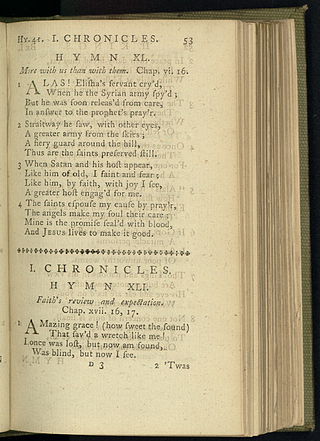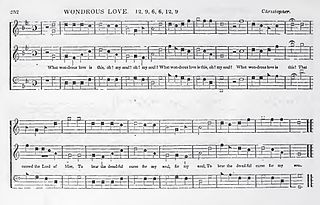Related Research Articles

"Amazing Grace" is a Christian hymn published in 1779, written in 1772 by English Anglican clergyman and poet John Newton (1725–1807). It is an immensely popular hymn, particularly in the United States, where it is used for both religious and secular purposes.

A hymn is a type of song, and partially synonymous with devotional song, specifically written for the purpose of adoration or prayer, and typically addressed to a deity or deities, or to a prominent figure or personification. The word hymn derives from Greek ὕμνος (hymnos), which means "a song of praise". A writer of hymns is known as a hymnist. The singing or composition of hymns is called hymnody. Collections of hymns are known as hymnals or hymn books. Hymns may or may not include instrumental accompaniment. Polyhymnia is the Greco/Roman goddess of hymns.

Polyphony is a type of musical texture consisting of two or more simultaneous lines of independent melody, as opposed to a musical texture with just one voice (monophony) or a texture with one dominant melodic voice accompanied by chords (homophony).

Gregorian chant is the central tradition of Western plainchant, a form of monophonic, unaccompanied sacred song in Latin of the Roman Catholic Church. Gregorian chant developed mainly in western and central Europe during the 9th and 10th centuries, with later additions and redactions. Although popular legend credits Pope Gregory I with inventing Gregorian chant, scholars believe that it arose from a later Carolingian synthesis of the Old Roman chant and Gallican chant.
Gospel music is a traditional genre of Christian music and a cornerstone of Christian media. The creation, performance, significance, and even the definition of gospel music varies according to culture and social context. Gospel music is composed and performed for many purposes, including aesthetic pleasure, religious or ceremonial purposes, and as an entertainment product for the marketplace. Gospel music is characterized by dominant vocals and strong use of harmony with Christian lyrics. Gospel music can be traced to the early 17th century.

Shape notes are a musical notation designed to facilitate congregational and social singing. The notation, introduced in late 18th century England, became a popular teaching device in American singing schools. Shapes were added to the noteheads in written music to help singers find pitches within major and minor scales without the use of more complex information found in key signatures on the staff.

"John Brown's Body", originally known as "John Brown's Song", is a United States marching song about the abolitionist John Brown. The song was popular in the Union during the American Civil War. The song arose out of the folk hymn tradition of the American camp meeting movement of the late 18th and early 19th century. According to an 1889 account, the original John Brown lyrics were a collective effort by a group of Union soldiers who were referring both to the famous John Brown and also, humorously, to a Sergeant John Brown of their own battalion. Various other authors have published additional verses or claimed credit for originating the John Brown lyrics and tune.
The music of Polynesia is a diverse set of musical traditions from islands within a large area of the central and southern Pacific Ocean, approximately a triangle with New Zealand, Hawaii and Easter Island forming its corners. Traditional Polynesian music is largely an inseparable part of a broader performance art form, incorporating dance and recital of oral traditions; most literature considers Polynesian music and dance together. Polynesian music expanded with colonial European contact and incorporated instruments and styles introduced through a process of acculturation that continues to the present day. Although the European tradition of hymn-singing brought by Christian missionaries was probably the most important influence, others are evident; Hawaii's influential kī hōʻalu music incorporated the Spanish guitar introduced in the late 19th century, and later introduced the steel guitar to country music. Hip hop and R&B influences have created a contemporary Urban Pasifika music genre with a strong Polynesian identity and supported by the annual Pacific Music Awards in New Zealand.
The music of the Cook Islands is diverse. Christian music is extremely popular. Imene tuki is a form of unaccompanied vocal music known for a uniquely Polynesian drop in pitch at the end of the phrases, as well as staccato rhythmic outbursts of nonsensical syllables (tuki). The word 'imene' is derived from the English word 'hymn'. Likewise the harmonies and tune characteristics / 'strophe patterns' of much of the music of Polynesia is western in style and derived originally from missionary influence via hymns and other church music. One unique quality of Polynesian music is the use of the sustained 6th chord in vocal music, though typically the 6th chord is not used in religious music. Traditional songs and hymns are referred to as imene metua.

"Good King Wenceslas" is a Christmas carol that tells a story of a tenth century Bohemian king who goes on a journey, braving harsh winter weather, to give alms to a poor peasant on the Feast of Stephen. The Feast of Stephen is December 26, the Second Day of Christmas in Western Christianity. In Eastern Christianity, it is December 27. [Need further clarification on whether it was celebrated on Dec 26 or 27 in Wencesalas's lifetime and region.] During Wenceslas's time, the Julian Calendar was in use. During the 900s, the day that they called December 26 was actually December 31 according to the Gregorian Calendar. And the day that they called December 27 was January 1.

Hula is a Hawaiian dance form expressing chant (oli) or song (mele). It was developed in the Hawaiian Islands by the Native Hawaiians who settled there. The hula dramatizes or portrays the words of the oli or mele in a visual dance form.

Christian music is music that has been written to express either personal or a communal belief regarding Christian life and faith. Common themes of Christian music include praise, worship, penitence and lament, and its forms vary widely around the world. Church music, hymnals, gospel and worship music are a part of Christian media and also include contemporary Christian music which itself supports numerous Christian styles of music, including hip hop, rock, contemporary worship and urban contemporary gospel.

The Seikilos epitaph is an Ancient Greek inscription that preserves the oldest surviving complete musical composition, including musical notation. Commonly dated between the 1st and 2nd century AD, the inscription was found engraved on a pillar (stele) from the ancient Hellenistic town of Tralles in 1883. The stele includes two poems; an elegiac distich and a song with vocal notation signs above the words. A Hellenistic Ionic song, it is either in the Phrygian octave species or Ionian (Iastian) tonos. The melody of the song is recorded, alongside its lyrics, in ancient Greek musical notation. While older music with notation exists, all of it is in fragments; the Seikilos epitaph is unique in that it is a complete, though short, composition.

The traditional music of Tuvalu consists of dances, including fatele, fakanau and fakaseasea. The influence of the Samoan missionaries sent to Tuvalu by the London Missionary Society from the 1860s resulted in the suppression of songs about the traditional religions or magic and many songs were lost. As the influence of the missionaries diminished in the 20th century the traditional dances were revived and the siva dance tradition from Samoa also became popular.
Himene tarava is a style of traditional Tahitian music.
Imene reo metua: a Cook Islands / Rarotongan term; : they are formal traditional songs with tune and harmony, which are distinguished from the imene tuki style of the Cook Islands which are less formal, often grunted verses with nonsense syllables included for rhythmic effect. Most were brought to the islands by missionaries in the nineteenth century.
Oe Himene are formal choral Tahitian songs, often of religious nature. Himene is a Tahitian term derived from the English word hymn.
A shout, ring shout, Hallelujah march or victory march is a Christian religious practice in which worshipers move in a circle while praying and clapping their hands, sometimes shuffling and stomping their feet as well. Despite the name, shouting aloud is not an essential part of the ritual march, which varies by congregation and locality.

"What Wondrous Love Is This" is a Christian folk hymn from the American South. Its text was first published in 1811, during the Second Great Awakening, and its melody derived from a popular English ballad. Today it is a widely known hymn included in hymnals of many Christian denominations.

The culture of the Cook Islands reflects the traditions of its fifteen islands as a Polynesian island country, spread over 1,800,000 square kilometres (690,000 sq mi) in the South Pacific Ocean. It is in free association with New Zealand. Its traditions are based on the influences of those who settled the islands over several centuries. Polynesian people from Tahiti settled in the Cook Islands in the 6th century. The Portuguese captain, Pedro Fernandes de Queirós, made the first recorded European landing in the islands in the early 17th century, and well over a hundred years later, in the 18th century, the British navigator, Captain James Cook arrived, giving the islands their current name. Missionaries developed a written language, bringing schools and Christianity to the Cook Islands in the early 19th century. Cook Islands Māori, also known as Māori Kūki 'Āirani or Rarotongan, is the country's official language.
References
- ↑ McLean, Mervyn (1999). Weavers of song: Polynesian music and dance, Volume 1999, Part 2. Auckland University Press. p. 80. ISBN 1-86940-212-X.
- 1 2 Alexeyeff, Kalissa (2009). Dancing from the Heart: Movement, Gender, and Cook Islands Globalization. University of Hawaii, Honolulu, Hawaii: University of Hawaii Press. p. 69. ISBN 978-0-8248-3244-5.
- ↑ Etches, Melina (25 July 2020). "Children embrace culture". Cook Islands News . Retrieved 17 August 2020.
- ↑ Riley, Frank (14 June 1979). "Pace Unhurried on Raratonga". The Los Angeles Times . Retrieved 17 August 2020– via Newspapers.com.